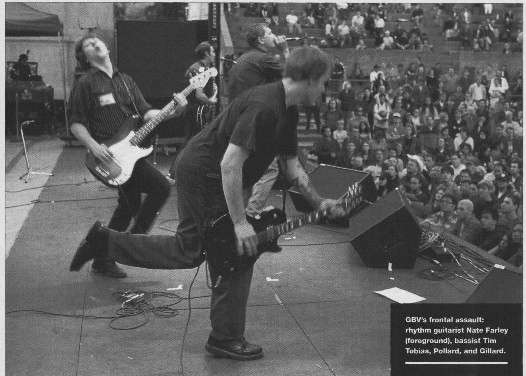
| Home | Fading Captain Series | GBV News | The Band | The Music | The Critics & Fans | Merchandise | Other Stuff |


After 15 years and ten
independent, lo-fi albums with his band Guided By Voices, songwriter Robert
Pollard made a leap into hi-fi territory. He had lost interest in the hissy,
muddy 4-track-cassette productions that had established the band’s early
reputation, and gladly accepted a major label’s plans to help him make a radio
ready record.
But Pollard and lead guitarist Doug Gillard—who can deliver pop hooks while
maintaining a garagey sound—had no plans to abandon the character of past
efforts, even though the band commissioned ex-Cars front-man and superstar
producer Rid Ocasek to oversee GBV’s Do
the Collapse (TVT).
Right off the bat, Ocasek had Pollard and Gillard add a new word to their
recording vocabulary: patience. Instead of recording an album over a three-day
period—as with past GBV records—Collapse required weeks of rehearsal and pre production. “I
talked to Ric on the phone for a month before I ever met him,” says Pollard.
“I gave him 35 songs or so, and we discussed which ones we were going to
do, and what we were going to do to them.”
Ocasek and the band whittled the 35 songs down to 22.
Of those, 16 made the final cut for the album. ‘All the other songs went
into this suitcase full of tapes,” says Pollard. “I call it my abandoned
song suitcase.”
Although Ocasek brought GBV from home-grown, 4-track cassette sessions to
big-time, 48-track productions—and worked the musicians bard to get the right
take—he sometimes surprised the band with his indie sensibilities. “We’d
do five or six takes of a song, and after the last take, I’d think, ‘Wow, we
nailed that,”’ says Gillard. ‘And then Ric would say, ‘Yeah, no one made
any mistakes. But I like the first take with the big old mistake because it
had a lot more feeling.”’
For the mandolin-like punctuations in “Wrecking Now,” Gillard played
Ocasek’s B.C. Rich 10-string along with his own Fernandes Elephant—’a
child-sized guitar with a battery-powered, built-in amp and speaker. In the
end, Ocasek preferred the character of the Fernandes (played with a capo).
“The Femandes gets this kind of Pignose tone,” says Guard. “It’s boxy,
but if you mic the speaker on the guitar, you get an interesting sound. As your
hand strums up and down, it produces a natural phase effect as it moves across
the speaker.”

GUIDED BY
RHYTHM
Ex-Breeders
guitarist and one-time GBV roadie Nate Farley on playing rhythm guitar with the
band an tour:
“I used to use thick
picks because I thought you couldn’t get a crunchy sound with a thin pick,”
says Farley. “But when I finally tried a thin pick, I realized I had more
control. You can hold the flimsy pick so it won’t bend, and you can still get
the crunchy sound out of it. So I switched to nylon Dunlop .060 picks.
“My
amp—a Laney AOR Pro Tube 1 OO-watt-— is really bassy. It even has a bass
boost, but I don’t use that unless the stage monitors are crappy and I need to
feel my guitar. I usually keep the treble at 6, t ikhdF67and the
bass at 4. I try to keep my sound on the clean side because the pickups on my
‘91 Gibson Les Paul Studio are real responsive. If you want to play heavy
stuff, all you have to do is play a little harder”